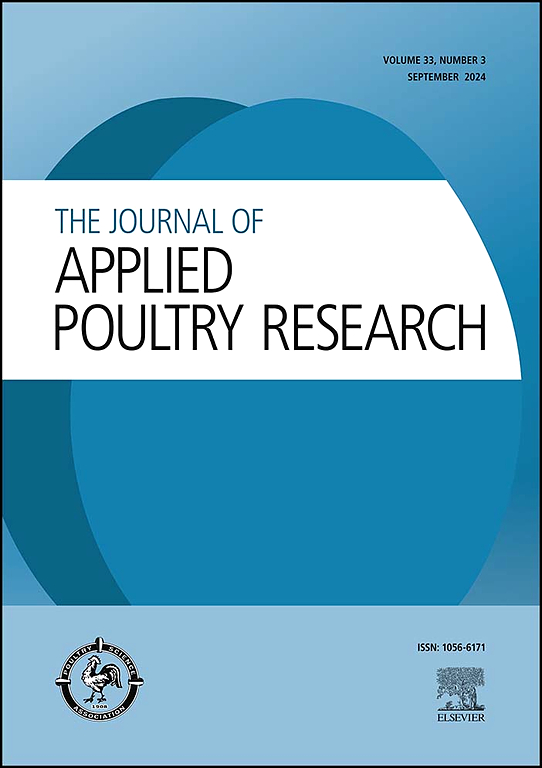Modeling the thermal inactivation of non-pathogenic and avian-pathogenic Escherichia coli in broiler mash feed with high initial moisture content using a lab-based circulating water bath
IF 2
3区 农林科学
Q2 AGRICULTURE, DAIRY & ANIMAL SCIENCE
引用次数: 0
Abstract
The Food Safety Modernization Act (FSMA) has stimulated the need for research into feed sanitation practices for feed producers, particularly breeder and backyard flocks. Feed can be a vector for poultry pathogens, such as Escherichia coli (E. coli) transmission to poultry, and appropriate feed manufacturing can help mitigate the feed pathogens with thermal treatments. This study aimed to apply existing models to quantify the thermal inactivation kinetics of two strains of E. coli during thermal processing between 75 and 95°C. Two-grams of feed sample were added with 200 µL of one of the two Nalidixic acid (NaL) adapted E. coli strains and submerged in a circulated water bath set at 75, 80, 85, 90, and 95°C, for heating between 0 and 180 s. United States Department of Agriculture (USDA) IPMP-Global fit software was used to calculate d-values from Weibull models and z-values from Linear models. Weibull model d-values were 19.80, 12.80, 10.40, 8.70, and 8.06 s for the APEC, and 8.00, 8.55, 5.30, 5.96, and 4.77 s for the non-pathogenic E. coli when heated at 75, 80, 85, 90, and 95°C, respectively. The z-values from Linear models were 51.6 and 81.3°C for APEC and non-pathogenic E. coli, respectively. Our results indicate the non-pathogenic E. coli may not be an ideal candidate for use as a pathogenic E. coli surrogate due to its lower thermal resistance than the tested APEC strain. However, these data validate the Linear and Weibull models are appropriate for predicting thermal inactivation of E. coli in broiler mash feed with a higher initial moisture content.
利用实验室循环水浴模拟高初始含水率肉鸡醪饲料中非致病性和禽致病性大肠杆菌的热灭活
《食品安全现代化法案》(FSMA)刺激了对饲料生产者,特别是饲养者和后院鸡群进行饲料卫生实践研究的需求。饲料可能是家禽病原体的载体,如大肠杆菌(E. coli)传播给家禽,适当的饲料生产可以通过热处理帮助减轻饲料病原体。本研究旨在应用现有模型量化两株大肠杆菌在75 ~ 95°C的热处理过程中的热失活动力学。取2克饲料样品加入200µL两种纳利迪酸(NaL)适应大肠杆菌菌株中的一种,并在75、80、85、90和95°C的循环水浴中浸泡,加热0至180 s。使用美国农业部(USDA) IPMP-Global拟合软件计算威布尔模型的d值和线性模型的z值。当温度分别为75、80、85、90和95℃时,APEC菌株的Weibull模型d值分别为19.80、12.80、10.40、8.70和8.06 s,非致病性大肠杆菌的Weibull模型d值分别为8.00、8.55、5.30、5.96和4.77 s。线性模型对APEC和非致病性大肠杆菌的z值分别为51.6和81.3°C。我们的研究结果表明,非致病性大肠杆菌可能不是作为致病性大肠杆菌替代品的理想候选者,因为它的耐热性低于所测试的APEC菌株。然而,这些数据验证了线性和威布尔模型适用于预测高初始含水率肉鸡醪饲料中大肠杆菌的热失活。
本文章由计算机程序翻译,如有差异,请以英文原文为准。
求助全文
约1分钟内获得全文
求助全文
来源期刊

Journal of Applied Poultry Research
农林科学-奶制品与动物科学
CiteScore
4.10
自引率
10.50%
发文量
80
审稿时长
104 days
期刊介绍:
The Journal of Applied Poultry Research (JAPR) publishes original research reports, field reports, and reviews on breeding, hatching, health and disease, layer management, meat bird processing and products, meat bird management, microbiology, food safety, nutrition, environment, sanitation, welfare, and economics. As of January 2020, JAPR will become an Open Access journal with no subscription charges, meaning authors who publish here can make their research immediately, permanently, and freely accessible worldwide while retaining copyright to their work. Papers submitted for publication after October 1, 2019 will be published as Open Access papers.
The readers of JAPR are in education, extension, industry, and government, including research, teaching, administration, veterinary medicine, management, production, quality assurance, product development, and technical services. Nutritionists, breeder flock supervisors, production managers, microbiologists, laboratory personnel, food safety and sanitation managers, poultry processing managers, feed manufacturers, and egg producers use JAPR to keep up with current applied poultry research.
 求助内容:
求助内容: 应助结果提醒方式:
应助结果提醒方式:


